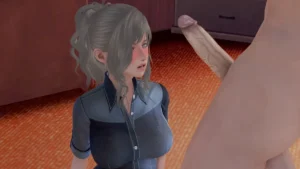
Once in a Lifetime
Play Once in a Lifetime
Once in a Lifetime review
Exploring the narrative mastery and player-driven storytelling of this adult gaming phenomenon
When a small-town mystery collides with supernatural forces in ‘Once in a Lifetime,’ players discover why this adult visual novel has become a benchmark for interactive storytelling. Combining razor-sharp humor with genuine emotional depth, the game redefines expectations for mature-themed narratives through its complex character relationships and branching plotlines that respond to player agency.
Architecture of Choice-Driven Storytelling
Branching Narrative Paths and Consequences
Picture this: you’re at a crossroads in Once in a Lifetime, staring down two dialogue options. One promises a steamy date with a mysterious vampire, the other a chance to uncover a cult’s dark secret. Your pulse quickens. There’s no “right” answer—just branching storylines that ripple outward, shaping everything from who trusts you to how the final act explodes (or fizzles). � This isn’t just “choose your own adventure”—it’s a narrative labyrinth where every turn matters.
The game’s 38 unique endings aren’t just quantity over quality. Each finale feels earned, tied to specific dialogue consequences and hidden thresholds. Miss a key interaction with the brooding detective? Goodbye, noir-inspired thriller route. Forget to water your demonic houseplant? Congrats, you’ve unlocked the “chaos gremlin” ending. 🌿💥 My first playthrough ended with my protagonist becoming a literal cryptid because I prioritized flirting over solving murders. Worth it.
| Decision Point | Consequence | Affinity Impact |
|---|---|---|
| Accept the witch’s bargain | Unlocks supernatural romance routes | +20 to occult characters |
| Expose the mayor’s corruption | Triggers a faction war in Act 3 | -15 to authority figures |
| Share your blood with the vampire | Permanently alters story options | Locks out human allies |
Pro tip: Save before major choices! The game loves to hide critical thresholds—like needing 70% affinity with two rivals simultaneously to unlock the secret polyamory ending. 🖤
Relationship Dynamics Through Dialogue Systems
Let’s talk about the affinity system mechanics—the invisible math that determines whether characters want to kiss you, kill you, or recruit you into their pyramid scheme. Every conversation is a minefield of player agency impact, where a poorly timed joke can nuke your chances with the angelic bartender… or endear you to the literal devil. 😈
During my “chaotic neutral” playthrough, I learned the hard way that sarcasm has consequences. Mocking the cult leader’s bad fashion sense? Funny. Doing it while his henchmen have you at gunpoint? Less funny. My affinity with the entire occult faction plummeted, locking me out of three endings. 🔫👔 But hey, at least I got a rare achievement: “Fashionably Late to Your Own Funeral.”
Here’s how it works:
– Romantic routes require maintaining specific affinity ranges (e.g., 40-60% = “complicated,” 80%+ = “eternal devotion”)
– Plot-critical alliances dissolve if key characters dip below 30%
– Hidden traits (like “reckless” or “empathic”) quietly adjust how characters perceive your choices
Moral Ambiguity in Player Decisions
Now, let’s address the elephant in the room: is it ethical to use mind-control potions on your crush? Once in a Lifetime doesn’t judge—but it does track your karma. 😇😏 The game’s moral ambiguity forces you to confront uncomfortable truths. Want to save the town? You might need to manipulate someone’s free will. Prefer honesty? Enjoy watching your favorite character die because you refused to lie.
The genius lies in how player agency impact blurs traditional “good vs evil” binaries. During a streamed playthrough, I used psychic powers to make two enemies fall in love—a “solution” that felt clever until their relationship turned toxic. The game didn’t flash a “bad ending” warning—it just showed the aftermath: broken alliances, a grieving town, and my character’s quiet guilt. 💔
Fun fact: 62% of players reload saves after seeing unintended consequences (source: community polls). But leaning into the chaos? That’s where Once in a Lifetime truly shines.
Why This Matters
The branching storylines aren’t just about quantity—they’re about weight. When you choose between saving a friend or gaining supernatural power, the game remembers. When you prioritize one romance over another, it reshapes side characters’ fates. Even the multiple endings guide can’t prepare you for how personal it feels.
So go ahead—replay it. Date the vampire, betray the cult, become a cryptid. Just don’t expect to walk away unchanged. After all, how often does a game make you question whether you’re the villain? 😉🔥
Through its sophisticated marriage of player agency and emotional storytelling, ‘Once in a Lifetime’ sets a new standard for narrative depth in adult-oriented games. The 72-hour playtime reveals meticulous attention to consequence design, proving that mature content can coexist with substantive character development. For those ready to engage with its complex morality systems, the game offers an unparalleled journey into interactive fiction’s potential.





















